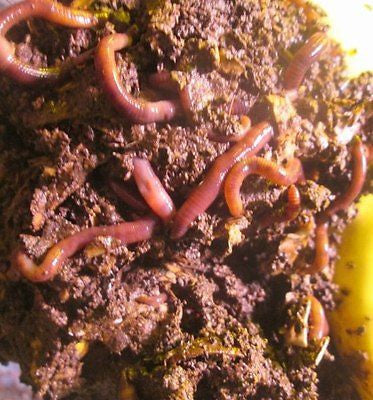Fast-composting red wigglers: Recycle waste effectively
Everything You Need to Find Out About Red Wigglers for Composting
Red wigglers, or Eisenia fetida, play a crucial duty in the world of composting, changing organic waste into important soil changes. Their special biological attributes allow them to grow in various conditions, making them a perfect choice for both amateur and skilled composters alike. Comprehending their requirements and benefits is important for establishing a productive vermicomposting system. Nonetheless, the process of setting up a worm container and keeping it can posture obstacles. To properly harness the capacity of these worms, one need to discover the intricacies of their treatment and monitoring.
What Are Red Wigglers?

(red wiggler worms near me)
Belonging To North America, red wigglers are surface-dwelling microorganisms that favor wet, warm environments abundant in disintegrating raw material. Their diet is composed mostly of decomposing plant product, food scraps, and various other organic particles, which they eat and damage down successfully. As they digest this product, they create nutrient-rich castings that enhance soil fertility.
Red wigglers are hermaphroditic, having both male and female reproductive body organs, and can duplicate swiftly under optimal conditions. Generally, red wigglers are vital factors to the procedure of reusing organic waste into important garden compost.
Advantages of Using Red Wigglers
Using red wigglers in composting systems supplies various benefits that enhance both the effectiveness of waste administration and the top quality of the resulting garden compost. These worms, scientifically called Eisenia fetida, are especially reliable at damaging down raw material, turning kitchen area scraps and backyard waste into nutrient-rich garden compost at an accelerated rate.
One of the primary benefits of utilizing red wigglers is their ability to take in big quantities of organic material, usually refining their weight in food waste daily. This high intake price causes quicker disintegration and lowers the quantity of waste sent out to land fills. The spreadings produced by red wigglers are rich in essential nutrients, valuable microbes, and enzymes, making them a superb plant food for yards and plants.
In addition, red wigglers grow in a selection of settings, making them adaptable for both indoor and outdoor composting systems - red wigglers. Their visibility in a compost container assists to aerate the material, protecting against smells and advertising a healthy composting process. Generally, utilizing red wigglers not only adds to efficient waste administration but additionally sustains lasting gardening techniques with the production of high-quality garden compost
(red worms)
Establishing Your Worm Container
To efficiently establish a worm bin, it is important to select a suitable container that fulfills the needs of red red wiggler worms near me wigglers while providing a favorable atmosphere for composting. An appropriate container can be made from plastic, timber, or steel, with a capacity of at the very least 1 square foot for each pound of worms.
Guarantee the container has appropriate drain openings to stop excess dampness, as red wigglers flourish in a damp, but not waterlogged, environment. red wigglers. The bin should also be ventilated to give enough air movement, protecting against anaerobic conditions that might hurt the worms
A perfect place for the worm bin is a great, dark area, devoid of straight sunlight and extreme temperatures, as red wigglers like a temperature level variety of 55 to 77 degrees Fahrenheit.
Prior to presenting the worms, prepare bed linen products such as shredded paper, cardboard, or coconut coir, which will certainly supply both environment and food. Moisten the bedding lightly to produce a welcoming environment for the worms. Last but not least, think about placing a cover on the bin to keep moisture and decrease insects, while ensuring it can be conveniently eliminated for maintenance.
Feeding and Treatment Standards
Feeding red wigglers is an important aspect of keeping a healthy composting system. These worms grow on a varied diet, mostly composed of organic products such as vegetables and fruit scraps, coffee premises, and crushed eggshells. It is necessary to stay clear of feeding them meat, dairy products, and oily foods, as these can create undesirable odors and attract parasites.
When introducing food to your worm container, chop or shred products into smaller items to help with quicker decay. Beginning with little quantities to gauge the worms' intake rate, slowly raising the amount as they adjust. It is advisable to alternating feeding areas within the bin to motivate comprehensive blending and oygenation of the compost.

Troubleshooting Common Issues
Maintaining a thriving worm composting system can sometimes offer obstacles that need attention and troubleshooting. Common concerns include an unpleasant odor, which often shows overfeeding or the existence of anaerobic conditions. To remedy this, lower the amount of food added and ensure correct oygenation by blending the bedding product.
One more frequent problem is the retreat of worms from the bin. This can take place due to extreme moisture or improper environmental problems. On a regular basis inspect the dampness levels, going for a damp but not soaked consistency, and keep ideal temperature levels between 60-80 ° F(15-27 ° C )to create a comfy habitat for your red wigglers.
Bugs, such as fruit flies, can also invade worm containers. red wigglers. To combat this, cover food scraps with a layer of bed linen or shredded paper to deter flies from laying eggs. Furthermore, ensure that any kind of food added is fresh and complimentary from mold, which can draw in unwanted parasites
Lastly, if your worms appear inactive, look for stress and anxiety elements such as temperature level fluctuations or inadequate dampness. Dealing with these usual issues will certainly aid keep a healthy and effective worm composting system.
Conclusion
In summary, red wigglers, or Eisenia fetida, play a crucial function in lasting waste administration via vermicomposting. Correct configuration and maintenance of a worm bin, along with adherence to feeding guidelines, guarantee a flourishing community that lessens garbage dump contributions.